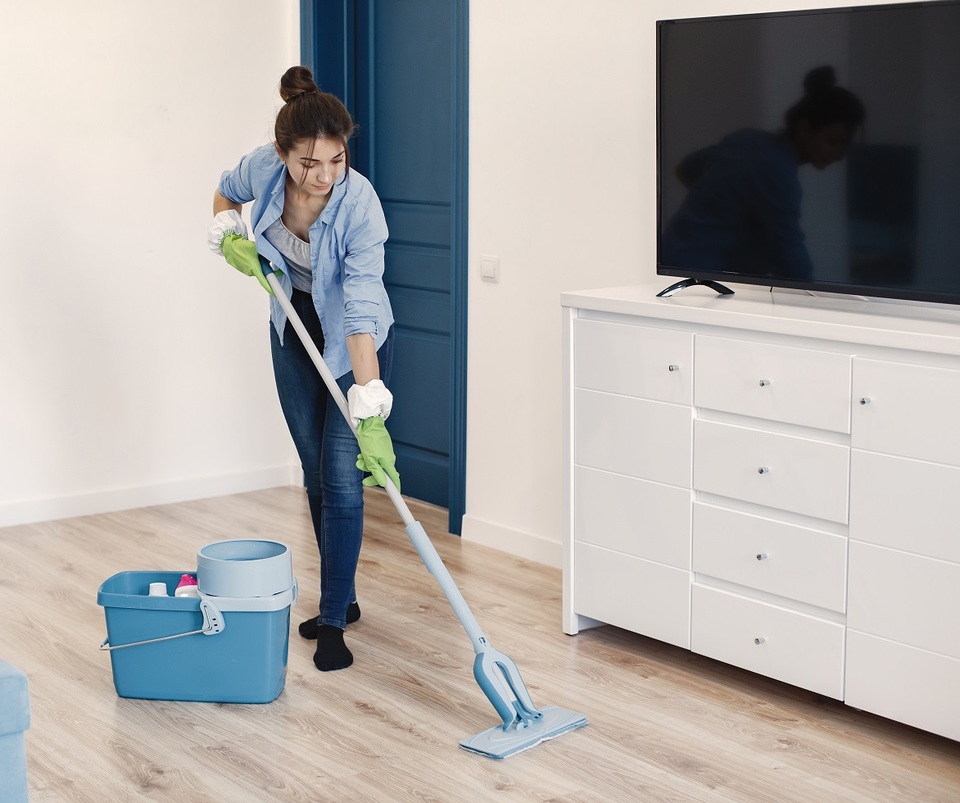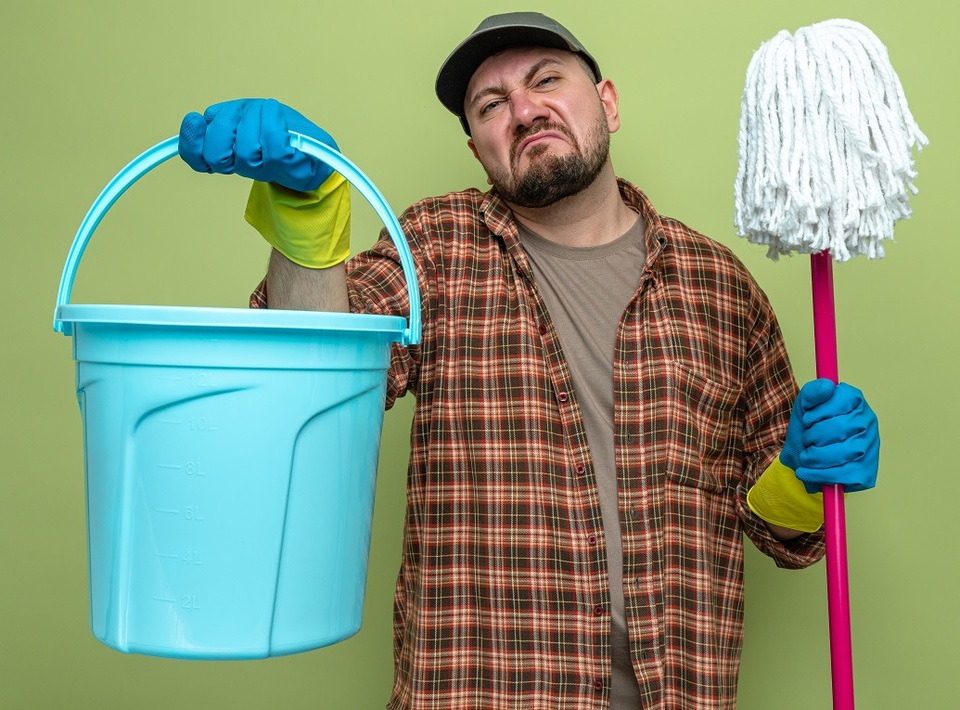How to clean a floor
Think you know how to clean a floor? Well, so did I? But in the name of good blogging, I dove in and googled “cleaning floors 101” and “how to clean floors”. I was surprised.
I did my research, read a multitude of articles on the topic of floor cleaning and below are my main takeaways (none of them actually make cleaning my floors any more fun).
Firstly, the Internet experts reckon you should sweep or vacuum floors in high-traffic areas, such as kitchens, dining areas, bathrooms, entryways, and hallways, every one to three days. Regular sweeping or vacuuming will maintain the finish and prolong the life of your flooring because it removes dirt and grit that can damage it.
When it comes to mopping, I’m of the school of thought that the best time to clean is when the floor looks like it needs it (unless you’ve got infants crawling on them which may change things). At our place, we can tell when the floor needs to be cleaned by simply looking at it or by checking the bottom of our feet after walking around barefoot.
Granted, our home does not get as much traffic as a public ‘restroom’ or a busy office toilet block which need daily cleaning. The experts recommend highly trafficked floors outside these areas are mopped once a week, or at least twice a month, with a proper cleaning solution to ensure a good deep-down clean.
Tips and tricks to cleaning your floor
There are a few key tricks to floor cleaning that can make a huge difference. The first one is removing dust, dirt and debris by sweeping or vacuuming, even in the bathroom. Skip this step, (tempting as it may be) and mopping will involve simply pushing wet dirt, dust, hair, and fur around into wet tiny clumps. This stage is also a good time to pre-wash any sticky, manky or generally unidentifiable spots with a sponge and soapy water or your preferred floor cleaning solution (assuming it's safe for your flooring, but we’ll get on the that part later).
Pick the right mop for your floor type
 Next, let’s look at your weapons of choice. You need to choose a mop and bucket(s) based on your floor type, and it’s not as straightforward as one would imagine. You need to do your homework. If you’re not careful and follow the advice of the floor manufacturer, you could be damaging your floors with every swish of a soaking wet mop. And you definitely don’t want to use too much water and run the risk of over saturating your floors. A sopping wet mop can damage a floor and dramatically extends the drying time.
Next, let’s look at your weapons of choice. You need to choose a mop and bucket(s) based on your floor type, and it’s not as straightforward as one would imagine. You need to do your homework. If you’re not careful and follow the advice of the floor manufacturer, you could be damaging your floors with every swish of a soaking wet mop. And you definitely don’t want to use too much water and run the risk of over saturating your floors. A sopping wet mop can damage a floor and dramatically extends the drying time.
If you have a textured floor, such as ceramic tile floors, you'll want to use the more classic string mop and buckets with built-in wringers. Sponge mops tend to smear dirty mop water around and that water settles into the porous grout. A string mop will leave your grout lines cleaner. But use two buckets. Use a second bucket for the rinsing water. Don’t rinse the mop in the same water used to wash the floor. A once-over after soaping with clean, warm water is essential.
If you have a smooth floor such as vinyl, a sponge or squeegee mop and any bucket with a handle will do the trick. Laminate flooring is one of the easiest to take care of. Laminates may look like real wood planks, tile or even natural stone, but are easier to clean. Simply use a microfiber or squeegee mop but be sure not to soak the floor. Getting water under the laminate will ruin it, although that does generally take a bit of doing.
Lino, real linoleum, is made from natural materials such as linseed oil, limestone, resin, cork, wood, and mineral pigments. It is fairly easy to take care of. You should treat it like any other natural flooring and only clean with a damp mop: use hot water and do not soak the floor. It can dry on its own or you can use a dry microfiber mop.
Wood and water do not mix, so only use a barely damp mop. Heavy mopping with water is not advised for cork, bamboo, or any other type of soft or hardwood floors. These floors are easily cleaned with a microfiber head mop. Microfibre mops are also handy for daily dusting and getting rid of light dirt. As for all wood floors, moisture is a danger that can cause the floorboards to warp and separate, so it is recommended to dry floors immediately after with a clean, dry towel.
Natural stone and concrete floors may be durable but never use harsh chemicals such as ammonia or bleach or vinegar on them. Nothing acidic should go near them. We sell Ph neutral floor cleaners specifically for the job. If your stone is unsealed, only clean with hot water and use no cleaners at all.
Floor cleaners
As we’ve mentioned, you need to follow the advice of the flooring manufacturer. Below is a list of products we carry and have been safely used on all sorts of New Zealand floors.
- Polished floors - Green Earth Floor Cleaner and Instaclean Floor Cleaner Cleanlab Floor Soft Green Rhino Neutral Floor
- General floor cleaning - Green Earth Floor Cleaner and Instaclean and No Rinse Floor Cleaner - Enzyme Wizard
- Heavy duty floor cleaning and degreasing - Heavy Duty Floor/Surface Cleaner - Enzyme Wizard Bio Clean
- Concrete floors - Green Earth Floor Cleaner, and Instaclean and Enzyme Wizard Heavy Duty Floor
- Vinyl floors - Green Earth Floor Cleaner, and Instaclean
- Antibacterial floor cleaner - Green Earth Disinfectant Cleaner Cleanlab Floor Antibacterial Cleanlab Antibacterial Heavy Duty Floor Cleanlab Low Foam Antibacterial
- NZFSA approval - Green Earth Floor Cleaner C32 Instaclean C25, Bio-Clean C32
The ‘no glug’ cleaning method
Next, the amount of cleaner you use is important. Always follow the instructions on the detergent label. Even if your floors are filthy, avoid the temptation to double up on the amount of cleaner you use in an effort to boost cleaning power (or speed). This is not a good idea. ‘Souped up’ cleaning water will not clean any better, it will just be harder to rinse off. It will leave a grimy residue and defeat the whole purpose.
Let the mopping begin
Begin mopping the floor, working from one end to the other, and moving backward so you are always standing on an unmopped. Make sure that you don’t mop yourself into a corner. Mop in straight lines if you are using a sponge or squeegee mop. For string mops, a figure-8 motion uses the design of your mop most effectively. As you work, keep an eye on both the washing and rinsing water. When they become visibly yuk, refill the buckets. For an extra cleaning step, you can mop over the entire floor with nothing but fresh hot water. Let your floor dry completely before walking on it.
Then there’s the clean up
Have you ever hung your mop it without giving it a good clean? Yeah, me either. As tempting as it is to just toss your mop back into the laundry, or wherever your cleaning products live, don’t. Clean your mop and let it dry before its next use. Trust me, you’ll be glad you did. Most mop strips or pads can be cleaned in a bucket with a little bleach and warm water, then wrung out to dry. You can just toss the microfiber pads into the washing machine.
Ah, clean floors! Enjoy them while they last
At Insinc, we sell floor cleaners for all commercial situations, and we specialise in environmentally friendly floor cleaning products. If you are concerned about damage to your polished floors, waxed floors, or laminated flooring, you will need a pH neutral cleaner. The Green Earth Floor Cleaner and Instaclean Floor Cleaners are pH neutral and can be used on any surface that is not harmed by water. If your floors get quite greasy then a degreaser will work for you.
If you would like to speak to a member of our team about floor cleaners for your business, simply call 0508 467 462. At Insinc we’re always here to help.
Posted: Wednesday 18 May 2022


